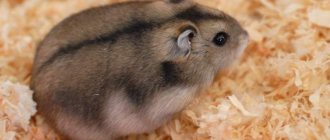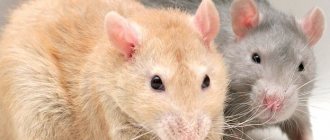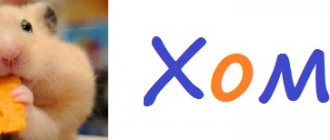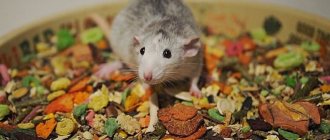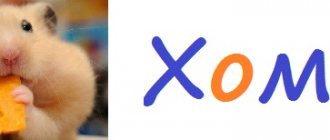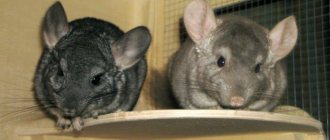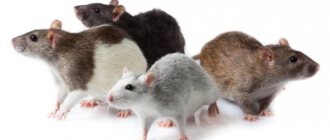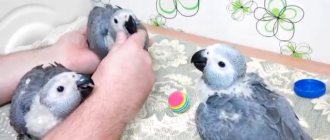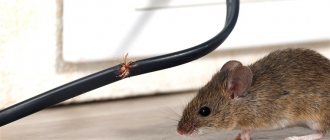Rats are incredibly intelligent creatures and make great pets for those who enjoy being nocturnal. There's no doubt that rodents can be a deterrent to many due to their reputation as dirty animals that sneak into homes and burrows and eat other people's food. However, with proper care and wisdom, many of us have found that these excellent students are quite easy to train and are also fun and intelligent pets.
However, to successfully keep rats, their cage must have good padding that will help the animal relax during the day and provide a comfortable base for running around at night. With the best litter, you can keep your rat alive for many years.
Why do you need filler?
Although it is possible to accustom a decorative rat to a litter tray, it is quite difficult. Usually small animals use the entire perimeter of the cage as a toilet. That is, the animal's urine and excrement fall directly onto the floor.
Naturally, in such conditions, especially if there are several animals in a cage, an unpleasant odor appears, and an excellent breeding ground is created for pathogenic microflora.
The function of the filler is precisely to absorb waste products and adsorb unpleasant pungent odors. Industrial compositions are very convenient to use, since to maintain cleanliness in the cage it is enough to just change the selected material 2-3 times a week.
Why do animals need bedding?
The method of use depends on the type of pet:
- mammalian predators (dogs, cats, raccoons, etc.) cover their excrement with bedding to hide their smell, so the “toilet” for the pet is installed outside its habitat;
- rodents defecate on the bedding, and also eat them from time to time (after all, many rodents are autocoprophages, that is, creatures that are not able to completely digest plant food the first time);
- Birds also defecate on the bedding, which absorbs their excrement, but spend most of their time above the bedding.
Types of fillers
Almost any pet store can provide a fairly wide selection of fillers, so each breeder will be able to choose from a variety of options the composition that is suitable for their pet.
Wood filler
Wood fillers are the most popular among rat owners. Their main advantage is their naturalness and ability to firmly lock in unwanted odors. There are several types of wood fillers:
- Shavings . It is represented by fairly large particles without any admixture of small fractions. The only contraindication for use is individual intolerance to the pet.
- Pressed filler . Sold in the form of granules and pellets. Too large particles make it difficult for small animals to move around the cage, so this type of filler will be ideal if there is a false bottom.
- Sawdust . It is worth giving preference to fillers made from deciduous trees, since pine sawdust often causes severe allergic reactions in rodents. Also, this type of litter contains a lot of wood dust, which can get into the respiratory tract and eyes of the rat. Therefore, it is better to buy sawdust only if there is a false bottom in the cage.
- Chips are the best option among wood fillers. Does not contain medium-sized dust particles, does not irritate mucous membranes. Just keep in mind that, as in the case of sawdust, it is better to choose chips from deciduous trees.
Depending on the manufacturer, sawdust can be quite rough and injure rats' feet. Therefore, a few days after using the purchased composition, you will need to examine the fluffy’s paws to make sure that everything is okay with him.
Paper filler
The best option among paper fillers is cellulose. It is absolutely harmless, does not injure the rodent's paws, and absorbs moisture well. However, it does not cope very well with unpleasant odors. Therefore, it is better to use cellulose only when keeping one animal in a cage, otherwise you will have to clean it daily.
Some breeders recommend using soft toilet paper or paper napkins as bedding. This option can only be considered temporary, since the paper quickly gets dirty, and rats are not averse to eating it.
Veterinarians recommend using paper napkins while caring for sick or weakened animals, since this filler is soft and absolutely hypoallergenic.
Some types of paper litter are strictly not recommended for use as bedding for rats:
- paper for office equipment - has sharp edges, can cause deep cuts, and absorbs moisture and odors very poorly;
- notebook sheets are also rough enough for rats' paws;
- old magazines and newspapers not only have low adsorbing properties, but are also a source of dangerous chemical compounds that make up printing ink.
It is recommended to cover the bottom of the cage in which a pregnant rat lives with shredded toilet paper and napkins. Firstly, paper filler is completely safe. Secondly, it is great for nesting - a caring mother will carry pieces of paper into an improvised nest.
Vegetable filler
Fillers of plant origin are considered environmentally friendly, which means they are safe for rats. The following varieties are presented on the zoological market:
- Corn . It is hypoallergenic and absolutely safe when eaten by a rat. Does not contain dust and small fractions. The size of the granules varies from medium to large. Suitable only for healthy and young rodents who are not obese. It is not suitable for weakened, aged and well-fed rats, as there may be difficulties with movement, as well as microtrauma.
- Hemp . An excellent option - environmentally friendly and well adsorbs urine and strong odors. When purchasing, you should give preference to products from trusted manufacturers, otherwise you may stumble upon litter mixed with dust and organic debris. The choice is made difficult by the almost complete absence of hemp fillers on store shelves. Typically, such bedding has to be purchased online.
- Linen . A fairly high-quality option - it retains odors and perfectly absorbs moisture. However, rarely, it can still cause allergies in rats. If the animal develops nasal discharge, swelling and redness of the mucous membranes, itching, the filler will have to be changed. Just not cotton, since it has similar properties.
- Herbal . It has excellent adsorbing properties. It is sold in the form of compressed granules, so it is recommended to use it only when living strong and healthy rats in a cage. It has one unpleasant property - when interacting with urine, it quickly gets wet and disintegrates. If you do not clean the cage in time, the rats will run through the grass slurry.
Some rat owners prefer to use hay as litter. However, such an undertaking is quite dangerous, since the hay contains many sharp blades of grass, debris and eggs of cattle parasites. When using such bedding, a rat can not only get injured, but also become seriously ill. In addition, hay has low adsorbing properties.
Inorganic filler
Among inorganic bedding, disposable diapers are considered the safest. But their use is advisable only when caring for a weakened rat during illness.
Firstly, the diaper constantly slides off, so you will have to secure it with masking tape. Secondly, most rats love to chew up such bedding and scatter the inner absorbent layer throughout the cage. However, if there is a false bottom, such problems can be avoided.
Also, a cage with a false bottom will be required when using other synthetic fillers, for example, silica gel and mineral, since when inorganic compounds enter the rat’s stomach, they completely block the animal’s digestive tract. Such situations often end in the death of rodents.
Rat cage size and interior decoration
When choosing a cage, you need to take into account the high activity of rats, as well as mandatory group housing (two or more). The minimum recommended space for each rat is 50 liters. With the caveat that “more is not less.”
So, for example, the volume of a Ferplast Furat cage is about 262 liters. You can keep no more than 5 rats in it, but for three animals it will be a real palace.
As already mentioned, not only size is important. A flat cage is not suitable for rats, no matter how spacious it may seem. But too narrow a base is also bad. The minimum recommended cage size for a rat: base 50x70 cm, height 80 cm. For one or two animals, a base 40x60, height 50-70 cm is acceptable.
Rats are social animals and need to live in communities.
The cage space will be divided into a recreation area and a dining area. Rats will also fuss and play, especially if they rarely go out for walks.
Arrangement of the "dining room"
Rats need constant access to fresh water. Closed (ball or nipple) drinkers are installed in the cage.
Hanging feeders or bowls are used for food. If there are a lot of rats, feeding should be organized so that the animals can approach the food at the same time. Then a bowl standing on the floor is more convenient. The optimal material is ceramics or glass. Metal and plastic ones are too light and constantly tip over.
To avoid quarrels and misunderstandings, all rats should be able to approach tasty food at the same time
You will need at least two bowls for feeding. One will always contain food (grain mixture), and the other will provide fresh food - vegetables and fruits, eggs, sour milk.
A mineral stone without salt is also fixed in the cage. Some rats ignore it completely, but they should have the opportunity to replenish the mineral deficiency.
Rat lunch: animals feast on yogurt
Read about what to feed pet rats HERE (link will open in a new tab)
Rest zone
Rats should be given the opportunity to hide in a cage. Without a secluded corner, they experience constant stress, become nervous and may get sick. That's why they put a house in the cage.
The rat must be able to hide
It can be made of hard plastic, wood, ceramic. You can even use a cardboard house as a temporary option. Although rats will quickly destroy it with their teeth (and the cardboard is soaked in urine), it is better than nothing at all.
Wooden houses are designed for hamsters, not rats. They quickly become saturated with urine and become unusable.
Plastic house "Sputnik" is suitable for young rats
And the plastic Sputnik XL is for adult rats
Most rats also like to sleep in a hammock - a suspended fabric bed. Chewing rats quickly make holes in your favorite hammock, and it also needs to be washed often. Despite these “cons,” homemade and purchased hammocks are very popular among rat breeders. Rats love them - why not make your pets happy?
Entertainment
In addition to the house and bowls, the cage may contain various tunnels, ladders and other devices for games and climbing. But it’s more convenient to use your imagination while walking, and leave the cage for rest. You can build mazes and cities for rats out of cardboard, and arrange obstacle courses with bait. And remember that there is no need to rearrange the cage. Some people try to “entertain” the animals and occupy their minds by rearranging objects in the cage after each spring cleaning. This will only lead to psychological distress. Rats get used to a certain environment and feel safe. They need regime and stability.
"Extra" equipment for rats
Here is a list of the most useless purchases for pet rats, no matter what the consultant at the pet store says:
- Toilet tray for rodents.
Rats are not characterized by cleanliness. On the contrary, marking with urine and feces is natural for them. Therefore, they will only use the toilet as a place to sleep.
Rats are not hamsters. They do not need to run 5-10 km every night. But even if you want to add some “physical exercise” to your pets, there are a few things to consider. Lattice wheels cannot be used - this risks serious damage to the tail and legs. Solid or fine mesh is acceptable, but such a wheel must be absolutely huge, with a diameter of 30 cm. Otherwise, the animal’s back will bend in an unnatural way.
The rat will most likely use the wheel not to run, but to take a nap. They see no point in running in one place.
Rats are not ordinary rodents. They have little in common with hamsters or guinea pigs
No comments here. Walking balls for rats are strictly not used.
Can I use cat litter?
Owners of several types of animals at once, for example, decorative rats and cats, are often interested in whether it is possible to fill the bottom of the cage with cat litter for convenience. It is strictly not recommended to do this, since cat litters contain minerals that release harmful substances when in contact with urine.
This is not harmful for the cat, since after going to the toilet the animal immediately leaves the tray. And the rat will have to run around the cage with the used toxic filler for at least several hours.
The only exception is wood cat litter. For example, Happy Paws or Pussy-Cat. Such compositions are absolutely safe for rodents. The main thing is that the size of the granules is suitable for the fluffy.
How to choose sawdust?
When choosing sawdust, you need to consider factors such as:
- excrement moisture;
- pet habits.
The wetter the feces of a living creature, the smaller the sawdust must be in order to effectively absorb it.
On the other hand, for animals that bury or eat excrement, it is advisable to choose larger waste materials.
Next we will talk about the behavioral characteristics of the most popular animals and the features of choosing sawdust for them.
How much do fillers cost?
The cost of litter for rats, depending on the manufacturer, varies from 100 to 1700 rubles per kilogram. Here are some examples of popular brands:
- Sawdust World of Wonders – 130 rub/kg;
- Corn granules Sanipet profumato – 273 rubles/kg;
- Cellulose filler-bedding PADOVAN HEMP BED – 353 RUR/kg;
- Paper filler CHIPSI Carefresh – 670 RUR/kg;
- Hypoallergenic hemp filler Natur Sreu HUGRO – RUB 1,537/kg;
- Mineral litter for rodent litter DUVO + “Potty Kit” (only for cages with a false bottom) – 1700 RUR/kg.
Also, when choosing a suitable filler, it is worth considering that it will have to be changed regularly. The frequency depends on the number of rats living in the cage. If the pet lives alone, replacing it once a week will be enough. If there are 2-3 rats in a cage - 2 times a week. If there are more than 3 animals - at least 3 times a week.
Most popular materials
All this allows us to determine the requirements for bedding , which should not interfere with pets to relieve their needs, while absorbing liquid and not mixing with solid fractions of feces.
Various materials can be used as bedding, the most popular of which are:
- paper torn into small pieces;
- sand;
- clay;
- silicate filler (silica gel);
- filler made of pressed sawdust or paper;
- fresh sawdust.
Collecting papers for a small animal is not difficult, especially if you have a paper newspaper subscription. However, for a large animal it is not easy to collect the required amount of paper, so it is used only for hamsters, small rats and mice.
In addition, when absorbing liquids, the paper becomes limp and sticks to the floor, which makes it difficult to remove.
In addition, paper does not eliminate the pungent odor of excrement, so soon the whole house will smell of pet waste products.
Sand is easy to buy in any city or town, but due to the need to change the contents of the tray at least every other day , even within a month you have to spend at least one bucket.
But it still needs to be put somewhere, and it is undesirable to throw sand into a garbage chute or trash can, so you will have to look for options for its disposal.
Stores offer a variety of litters suitable for use in such toilets, made from compressed sawdust or paper. Such fillers absorb liquid well and eliminate odor, but the cost of a 5 kg bag, which will last even a hamster for a maximum of a month, is rarely less than 400 rubles.
If you add it to a larger animal, you will need 1-3 bags per week, which is very expensive for the budget.
Sawdust is not inferior to sand, clay or silicate-based filler in its ability to absorb liquid and prevent the spread of odors, and is 10–15 times cheaper .
You can read more about the cost of sawdust from various types of wood here.
If you don't know where to find good sawdust, we recommend reading this section.
We also recommend that you read the article about the types of sawdust, from which you will learn how they differ from each other and which of them are considered high quality.
What to consider when choosing bedding
The variety of fillers in pet stores literally makes buyers' eyes widen. But you shouldn’t take the first package you come across. To choose a quality filler, you need to pay attention to the following criteria:
- The ratio of price and volume of the package . When assessing the cost of filler, it is better to convert all prices into costs for a certain volume, for example, per 1 kg or per 1 liter. High-quality compounds cannot be too cheap. But an inflated price does not guarantee that the filler will do its job well.
- Compound . On the back of the package, the manufacturer must indicate the substances that make up the filler. The main thing is that this list does not contain chemicals and minerals.
- Special notes . For example – “hypoallergenic”, “medium fraction”, “for large rodents”, “can be flushed down the toilet”.
Also, when choosing litter for a rat, special attention should be paid to the reputation of the manufacturer. To do this, you can study reviews of real customers left on online store sites.
Conclusion
The right choice of litter or bedding for your pet is no less important than the right choice of food.
At the same time expensive products praised by sellers in stores are not always suitable . After all, when choosing a bedding or filler, you need to focus not only on the beautiful packaging and pleasant smell, but also on the effect it has on your pet.
Therefore, natural sawdust from the nearest sawmill or wood processing plant is much better suited for most pets than any other means.
What is the best filler to use?
It is difficult to name an ideal manufacturer of industrial compounds. When choosing a filler, you must first focus on the individual characteristics and preferences of the rat.
For example, if your fluffy constantly chews everything that doesn’t fit well, it’s better to choose natural corn granules. They are absolutely safe for the health of the animal, hypoallergenic and easily digestible. In addition, they do an excellent job with their main function.
If the rat requires care during the postoperative period, it is recommended to use disposable diapers until the pet fully recovers. They are soft, absorb exudate well, and allow the animal to move easily. They are also very easy to change if necessary.
When keeping males whose marks have a persistent, specific odor, it is better to use hemp or wood filler. Such compositions perfectly adsorb unwanted aromas.
For convenience, when choosing the appropriate composition, you can use a short comparative table.
| Material | Advantages | Flaws |
| Sawdust | environmentally friendly; | contain dust; |
| do not injure the paws; | Conifers cause allergies. | |
| retains odor well. | ||
| wood chips | perfectly locks out odor; | rarely causes allergic reactions. |
| does not contain toxins; | ||
| without impurities of small fractions. | ||
| Corn | has high adsorbing properties; | large granules are inconvenient for the movement of weak and large rodents. |
| safe to eat. | ||
| Cotton | instantly absorbs moisture; | plant components can cause allergies. |
| holds odor well; soft. | ||
| Cellulose | pleasant to the touch; | quickly eaten by rodents; |
| quickly absorbs urine; | Doesn't block odors very well. | |
| hypoallergenic. | ||
| Hemp | hypoallergenic; | difficult to buy - not available on store shelves. |
| holds unpleasant odors well; | ||
| soft. | ||
| Paper granules | retains odors best; | needs to be changed frequently. |
| silent; | ||
| non-toxic; | ||
| allowed to flush down the toilet. |
What to do if a rat eats litter
It's no secret that rats taste literally everything that comes their way. Therefore, you should not be surprised that one day the animal will get to the filler. Just don't panic, most industrial formulations are made from natural materials - wood, corn, hemp and other herbs. Such “dishes” will not bring any harm to the pet. Over time, the animal will switch to something tastier and lose all interest in them.
If your pet chews synthetic or paper litter, you will simply need to replace it with a safe composition. However, it is unlikely that a replacement will be needed; most likely, the rat will understand that the litter has no nutritional value and will refuse to use it.
If a rodent owner cares about the health and well-being of his pet, then he will definitely need to find out why rat litter is needed, which is best to use, and the cost of industrial compounds. After all, without high-quality bedding it is difficult to imagine good care for a fluffy. The main thing is to study all the pros and cons of fillers offered on the zoological market and make the right choice.
Video description
An example of how mice “taste” the insulation, but do not stay in it, in this video:
However, rodents can gnaw passages in ecowool to get to more “edible” material. How can they build nests in insulation that was produced in violation of technology and is not impregnated with special compounds.
Ecowool is considered one of the best thermal insulation materials, as it is installed without seams, is not afraid of moisture and has good fire resistance due to fire retardant impregnation. Its disadvantages are the difficulty of installation by spraying and large shrinkage when installed in bulk.
